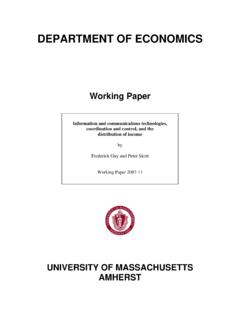Transcription of Pre-revolution living standards: Russia 1888-1917 ...
1 Pre-revolution living standards : Russia 1888 -1917. Ekaterina Khaustova (Russian State Social University (Kursk Branch)). Preliminary version April 2013. This paper was prepared for the 2013 Annual Conference of the Economic History Society. Any comments are very much appreciated. E-mail: Title: Pre-revolution living standards : Russia 1888 -1917. Ekaterina Khaustova, Russian State Social University (Kursk). Abstract After 1917 Russia underwent extraordinary transformations. Its capitalist based economy was reshaped to centrally-planned economic system. Recent studies rest upon the shared assumption that the effect of adverse social, geographical, political or historical conditions persisted over that time, keeping pre- revolution Russian economy behind and stimulating workers to fight.
2 Many samples of previous research drawn by economists of Soviet era, which were reflected on the results. However was it really so bad? Our reconstruction of Russian living standards scrutinizes real wages structure distribution per capita, income levels divided between the two main cities (Moscow and ) and groups of workers. We adopt Robert C. Allen subsistence basket methodology. This study has shown the that the annual wages earned by male adult workers sufficed to sustain a household at subsistence level for the entire pre- revolution period, with the exception of the years 1916-1917. International comparisons with some developed European cities have shown that the picture of Russian labour-class living standards is much wider and needs historical and economical revision.
3 Key words: Russian revolution , living standards , labour wages, food price, welfare levels. Inrtoduction After 1917 Russia underwent extraordinary transformations. Its capitalist based economy was reshaped to centrally-planned economic system. Even on the threshold of a hundred year anniversary of Russian revolution many issues remain unresolved. Economic historians of 20th century Russia focused their attention on pre-revolutionary economic problems and in many classical books Russia looks a lot like lugging part of Europe. Over recent years some Russian historians increasingly analyzed and reviewed this part of Russian economic history. Some scientists assume that due to a number of unfavorable social, geographical, political or historical conditions which remained over that time, the economy of pre- revolutionary Russia was left behind and labour class was encouraged to fight.
4 Others believe that economic failure and weakness were the main reasons of Russian revolution 1917. Others have attributed Russian revolution 1917 to economic failure and weakness. 2. Russia 's bad set of financial institutions has often been cited as a possible cause of revolution too. There are lots of complications on the way to the study of this aspect. Perhaps the most discussed problem is that the unfavorable conditions impacted the results of previous research drawn by economists of Soviet era. Their main conclusion is that labour class was affected by horrible poverty. Perhaps not the most surprising is that this conclusion is based on limited evidence. Were workers affected by poverty or were economical and political change on the air and easily changed mood of people?
5 Much has been written on the importance of fast change for economic development. However was it really so bad? Meanwhile, if we look on the situation impartially, we can see much more than a common view of that period of time. Historical background If history matters for what we truly believe in, we need to make some historical review. At the end of 19th century Russia was in the first place in population growth. For the 100 years before, Russian population has increased by 111 million, 637 thousand, or times, and the increase was caused by country residents. Absolute increase in population and its rate was in the period between 1863 and 1913. There were also significant differences between the rates of population growth of 50 provinces of European Russia .
6 Russian population from 1863 to 1913 (without Poland and Finland) grew at 122,2% , in particular from 1897 to 1913 at 33,7% . Highest population growth was in the Caucasus and Siberia, mainly because of internal _____. 1. See Rashin Russian population for 100 years . 3. Between 1861 and the revolution of 1905, rural Russia experienced significant social and economic change. Emancipation of the serfs began a sequence of reforms designed to improve the civil rights of the rural population. The land reforms that accompanied emancipation transferred property rights from the gentry and the state to the peasantry. The expansion of the railway network and growing integration with global markets led to increased regional specialization as grain exports boomed in the south and substantial industrial growth took place in the north-central In the late XIX early XX century the Russian government took a number of measures to strengthen the role of Russia in the world economy, namely: stimulation of economic growth through industrial development, improvement of public finances, stabilization of the ruble by the introduction of the gold standard, protectionism, and expansion of transport infrastructure.
7 This study assesses the impact of the above mentioned measures on the formation of investment climate in Russia in 1885 1913. The years 1885 1913 are considered as an integral period from the point of view of the conducted economic policy, and, consequently, its impact on the investment climate. It should be noted that success in the development of Russia in the late XIX early XX. century is traditionally associated with the policies of Sergei There was a rapid growth of cities and urban population, however urban population grew slower than total population. The rising demand for labour in Russian cities is unquestionable. W. Rostow believed that at the end of XIX early XX century Russia has entered a stage of take-off with self-sustained growth4.
8 According to P. Gregory during 1885-1913. the growth rate accounted for per year, and per capita per year5. In comparison with the developed countries of the time Russia was one of the fastest growing economies. _____. 2. Micro-Perspectives on 19th century Russian living standards . Tracy Dennison & Steven Nafziger 3. Government Economic Policy and the Formation of Investment Climate: The Experience of Russia in theLate Nineteenth Early Twentieth Century Natalia P. Drozdova ,Irina G. Kormilitsyna. 4. Rostow, 1990, p. xviii 5. see Gregory, 1982, p. 192. 4. Industrial growth rates were significantly higher than the average for the national economy and for the years of industrial expansion (1885 1913) reached , and in 1890-ies even During the period the average annual growth rate of industrial production in the amounted to , in the UK , in Germany , in Sweden 6.
9 Thus at the turn of the XIX XX century Russia held one of the first places in the world for the pace of industrial development. A characteristic feature of the reform era was growth of the urban population. High taxes and redemption payments for land made peasants flock to cities and industrial towns, factories, mining industries and to railway construction in order to earn money to survive. The influx of cheap labour was one of the most important factors in capitalization of the country. From the second half of nineteenth century manufacturing begins to develop rapidly. In the European part of Russia , especially in Moscow and Moscow region, Donbas, Volga region and St. Petersburg region numerous factories were built. The most intensively developed branch of industry was metallurgy, textile industry and construction.
10 By the early 80's of nineteenth century, along with continued development of handicrafts, the role of factory production was increasing. An important feature of its formation was gradual transition from manual labour to mechanization. The greatest development of machine technology was in the manufacturing sector. Metallurgy industry, which contained of all engines and concentrated of all workers, gave of total production industry. Rising demand for manufactured goods caused innovation and production increase during the nineteenth century and the beginning of twentieth century. Large investments have ensured rapid railway development. If in 1860 the construction length of the railway network in Russia was 1626 km, then in 1870 it increased to 10,731 km, in 1880 this figure reached 22,865 km.





